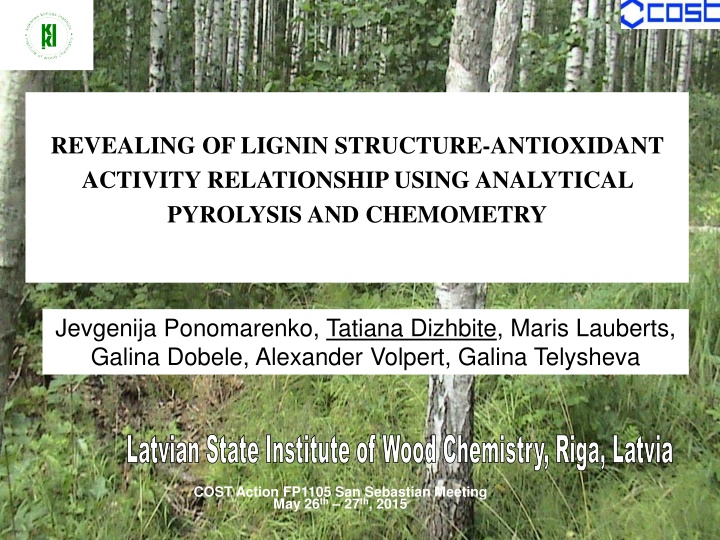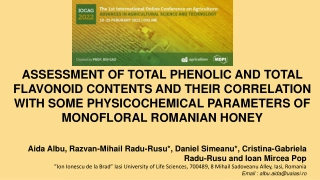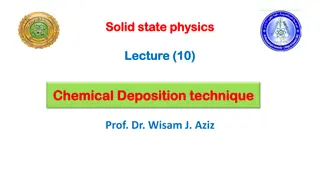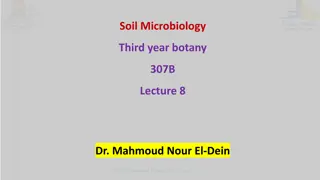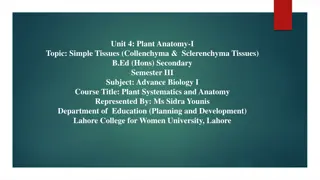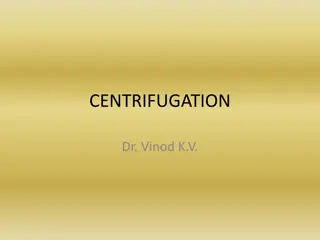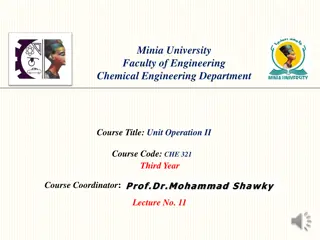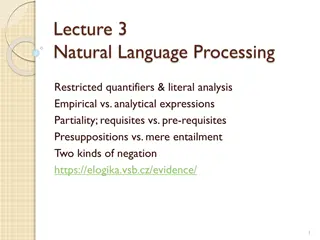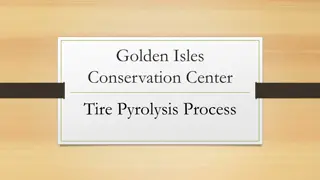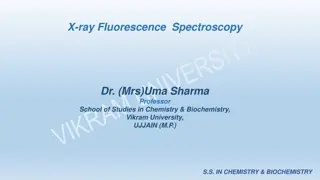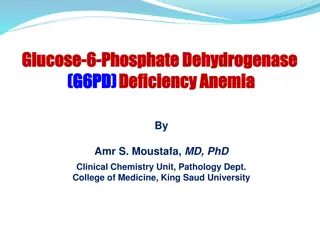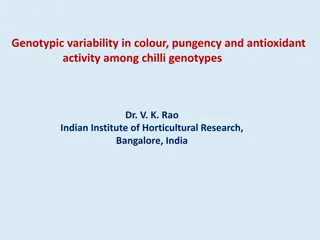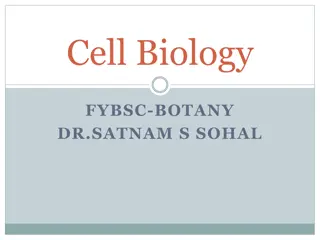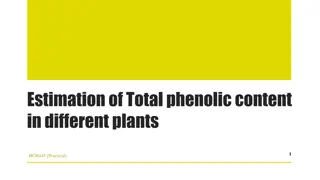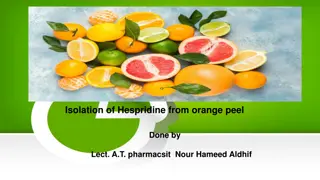Revealing Lignin Structure-Antioxidant Relationship Using Analytical Pyrolysis
Relationship between lignin structure and antioxidant activity explored through analytical pyrolysis and chemometry techniques, aiming to identify optimal antioxidants for various applications. Study involved characterization and quantification of structure-antioxidant activity relationship for lignins obtained from different sources and isolation techniques. Antioxidant activity of lignins investigated using deactivation methods of DPPH and ABTS+ radicals.
Download Presentation

Please find below an Image/Link to download the presentation.
The content on the website is provided AS IS for your information and personal use only. It may not be sold, licensed, or shared on other websites without obtaining consent from the author.If you encounter any issues during the download, it is possible that the publisher has removed the file from their server.
You are allowed to download the files provided on this website for personal or commercial use, subject to the condition that they are used lawfully. All files are the property of their respective owners.
The content on the website is provided AS IS for your information and personal use only. It may not be sold, licensed, or shared on other websites without obtaining consent from the author.
E N D
Presentation Transcript
REVEALING OF LIGNIN STRUCTURE-ANTIOXIDANT ACTIVITY RELATIONSHIP USING ANALYTICAL PYROLYSIS AND CHEMOMETRY Jevgenija Ponomarenko, Tatiana Dizhbite, Maris Lauberts, Galina Dobele, Alexander Volpert, Galina Telysheva Latvian State Institute of Wood Chemistry, Riga, Latvia COST Action FP1105 San Sebastian Meeting May 26th 27th, 2015
Motivations and Goal Different materials, food products, means for human health care, etc. undergo oxidative degradation. In order to protect their properties and prolong their life- time, antioxidants have to be added to almost all organic substrates. The overall antioxidants markets, where share of natural antioxidants is accounted for ~30%, is valued at about USD 2 billions per year. Demand for natural antioxidants is constantly increasing and the search for new renewable resources for their manufacture is an urgent task. The antioxidant activity of bio-renewable polymeric polyphenol lignin is well documented for a variety of polymeric composite materials, animal feed, and biological systems, however, the systematic investigations of mechanisms of the lignin antioxidant action and structure antioxidant activity relationship are performed much more seldom. Structure activity relationship is crucial to identify the most optimal antioxidants and to determine the most promising directions for upgrading of technical lignins in order to produce effective antioxidants for various application systems. The aim of the work was characterization and quantification of the structure antioxidant activity relationship (SAR and QSAR, respectively) for lignins. COST Action FP1105 San Sebastian Meeting May 26th 27th, 2015
Materials and Methods 50 lignin samples obtained as by-products of the chemical processing of phytomass were the objects of the study. They differed by botanical origin (annual plants, deciduous trees) and the isolation technique (alkaline, organosolv, kraft processes, the Bjorkman method, fast pyrolysis, hydrolysis). The 9 structural descriptors, chosen on the basis of our previous studies of antioxidant activity of lignins and lignin-related low- molecular phenols were determined using mainly Py-GC-MS/FID and FTIR, EPR, SEC and wet-chemistry as complimentary methods. Principal component analysis (PCA) showed that the chosen structural properties, together with the number of the samples, allowed to join all lignins under study in one group, without dividing them into clusters, depending on the botanical origin and/or the processing method. coniferous trees, Structural model of softwood lignin (G. Brunow et al. 2001) OCH3 HO OCH3 OH O OH O OCH3 Structural model of a hardwood lignin fragment (J. Ralph et al., 2004) OH OH H3CO HO H3CO O OCH3 HO O O O H3CO OCH3 H3CO H3CO OH OH OCH3 HO loadings of the lignins in PC1 and PC2 COST Action FP1105 San Sebastian Meeting May 26th 27th, 2015
Materials and Methods Antioxidant activity For the investigation of antioxidant activity, the methods of the deactivation of DPPH and ABTS +radicals were applied. A combination of these methods allows to gain information about the reactions of low molecular phenols with radicals by both proton coupled electron transfer (PCET) and sequential proton lost electron transfer mechanisms (SPLET) as well as about the stoichiometry of the reactions. PCET mechanism: ArO-H + R ArO + R-H BDE=H (ArO )+H (H )- H (ArOH) SPLET mechanism: ArO-H ArO- + H+ ArO-+ R ArO + R- R- + H+ RH ETE = H (ArO ) + H (e-) - H (ArO-) The antioxidant activity was expressed as radical deactivation index (RDI): number of deactivated radicals, calculated per one phenolic hydroxyl group of lignin. The use of this parameter prevents the expression of activity per gram of a polymer or an extract (which is not suitable for the structure-activity studies) The multivariate regression and correlation analysis were used to describe the influence of lignin structural parameters on antioxidant activity and to obtain a model, which gives quantitative information about their contribution. COST Action FP1105 San Sebastian Meeting May 26th 27th, 2015
Results: SAR For the studies of the correlation between the structure and antioxidant activity, partial correlations were used, because each structural property could influence the antioxidant activity of lignin. In the case of lignins, the structural parameters, which influence the antioxidant activity in the DPPH tests, can easily be explained by means of the PCET mechanism. The factors, which determine the antioxidant activity in the ABTS +test, show the contribution of SPLET mechanism. Pearson s correlation coefficient (n=50, a=0.05) Critical value = 0,28 DFPH 0,58 0,47 -0,48 Antioxidant activity descriptors ABTS + -0,18 0,22 -0,27 Relative content of G+S phenols, % CH2-groups in the a-position of the side chain, % Oxygen-containing groups in the side chain, % Size of the p-conjugated systems, number of H atoms in spin delocalization region Double bonds in the a-position of the side chains, % Carbohydrates, % (ArC1+ArC2)/ArC3 -OCH3/PPU Mw, g/mol -0,34 -0,45 0,01 -0,10 0,08 0,19 0,04 0,21 -0,58 0,74 0,05 -0,11 COST Action FP1105 San Sebastian Meeting May 26th 27th, 2015
Results: QSAR The results of PCA were used for precise the chosen structural descriptors for lignin QSAR , For the QSAR studies, the multivariate Correlated Component Regression (CCR) analysis was used and the structure-activity relationships equations were obtained on the basis of the DPPH and ABTS +tests results. YDPPH = -3.08+0.043 X1+0.018 X2- 0.018 X3-0.014 X7+0.24 X8 YABTS += 1.46 -0.013 X3-0.015 X4+0.050 X5- 0.018 X7+0.32 X8 Predicted and experimental RDI values in the DPPH test Predicted and experimental RDI values in the ABTS + test COST Action FP1105 San Sebastian Meeting May 26th 27th, 2015
Results: QSAR According to the results of the CCR analysis, the structural descriptors, which determine the lignin antioxidant activity by PCET mechanism, can be classified by their contribution as relative content of the G+S phenylpropane units (0.51) > relative content of the phenylpropane units with CH2-groups in the -position of the side chains (0.37) > relative content of the phenylpropane units with oxygen-containing groups in the side chains (-0.40) > size of the systems (-0.23) > OCH3/PPU The structural descriptors, which determine the lignin antioxidant activity by SPLET mechanism, can be classified by their contribution as follows : (ArC1+ArC2)/ArC3 (0.92) > relative content of carbohydrates (-0.51) > relative content of phenylpropane units with oxygen-containing groups in the side chains (-0.33) > size of the -conjugated systems (-0.32) > OCH3/PPU (0.16). The obtained results are in agreement with the results of PCA. The coefficient of determination, which shows the part of the variation of the antioxidant activity, which can be explained by the descriptors included in the model, is 0.76. The obtained model can successfully be used for the prediction of the antioxidant activity of technical lignins, however approximately 24% of the factors, influencing the antioxidant activity of lignins still remain unclear. -conjugated COST Action FP1105 San Sebastian Meeting May 26th 27th, 2015
PUBLICATIONS 1. J. Ponomarenko, T. Dizhbite, M. Lauberts, A. Viksna, G. Dobele, O. Bikovens, G.Telysheva, Characterization of softwood and hardwood LignoBoost kraftlignins with emphasis on their antioxidant activity, Bioresources 9 (2014)2051 2068.[30] 2. Ponomarenko J., Trouillas P., Martin N., Dizhbite T., Krasilnikova J., Telysheva G. Elucidation of antioxidant properties of wood bark derived saturated diarylheptanoids: A comprehensive (DFT supported) understanding. Iesniegts public anai urn l Phytochemistry 103:178 187. 3. J. Ponomarenko, T. Dizhbite, M. Lauberts, A. Volperts, G.Dobele, G. Telysheva, Analytical pyrolysis A tool for revealing of lignin structure-antioxidant activity relationship, J. Anal. Appl. Pyrol. (2015), http://dx.doi.org/10.1016/j.jaap.2015.02.027 4. J. Ponomarenko, T. Dizhbite, M. Lauberts, L. Lauberte, V. Jurkjane, G. Telysheva, Antioxidant activity of various lignin nd lignin-related phenylpropanoid units with high and low molecular weight, Holzforschung. ISSN (Online) 1437-434X, ISSN (Print) 0018-3830, DOI: 10.1515/hf-2014-0280, April 2015 COST Action FP1105 San Sebastian Meeting May 26th 27th, 2015
Thank you for your attention! COST Action FP1105 San Sebastian Meeting May 26th 27th, 2015
